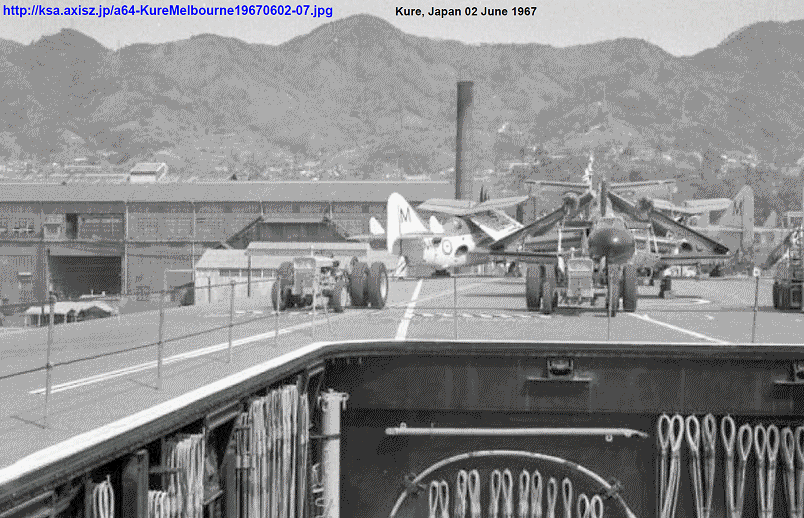Carriers
Question from a non-pilot. If you look at the Super Etendard on the catapault there is an A-frame type device under the airframe to get it at the right angle of attack. I always wondered where the device went, but in this video you can see a splash after take off. Do I assume it is a 'consumable' item, and what if the ships props hit it (sorry if this is a dumb question).
Join Date: Apr 2009
Location: Sydney
Age: 45
Posts: 243
Likes: 0
Received 0 Likes
on
0 Posts
That's actually a wire strop to launch the aircraft and has no effect on the pitch angle as the aircraft sits on the deck. The new system is to use a nose wheel mounted launch bar which connects straight into the shuttle on the catapult. If you have a look at 1960's carrier footage you will see all aircraft launched this way and i'm not sure which was the first to make the switch but it may have been the A6 or A7.
But what happens to the wire strop?. Does it end up in the oggin?. If you look at 1.59 you can see a splash as the aircraft leaves the deck. I presume this is the wire strop being dropped into the drink (but I could be wrong). If this is the case does this mean they have to carry a big stock of wire ropes?.
Yes. US carriers up to Carl Vinson and in the RN, Ark Royal IV, were fitted with the "bridle catcher" invented by a bloke called Willem Van Zelm. The idea was to be able to re-use the bridles up to a certain number of launches, before they would be gashed as scrap.
Basically there is an extension to the flightdeck forward of the cat, where the flying strops (steel wire ropes doing over 100kts!) are "caught" and held below FD level until after the launch cycle is complete, when they are recovered. Extensive use of nose-tow launching in new aircraft designs meant that bridle launches eventually became rare events, but the SEM still uses that method.
CdG does not have them as she was originally planned to have a mostly Rafale complement and so bridle catchers never fitted (Foch & Clemenceau did have them). That means she will have to have a large supply of tested and in date bridles for her SEM as they will disappear into the 'oggin in short order.
Basically there is an extension to the flightdeck forward of the cat, where the flying strops (steel wire ropes doing over 100kts!) are "caught" and held below FD level until after the launch cycle is complete, when they are recovered. Extensive use of nose-tow launching in new aircraft designs meant that bridle launches eventually became rare events, but the SEM still uses that method.
CdG does not have them as she was originally planned to have a mostly Rafale complement and so bridle catchers never fitted (Foch & Clemenceau did have them). That means she will have to have a large supply of tested and in date bridles for her SEM as they will disappear into the 'oggin in short order.
You can briefly see a very young Dave Hansom walking out to his phantom on Ark Royal. Dave very sadly passed away last week - various condolence threads. Dave was a very good friend and if asked would tell some fascinating stories of flying the F4 of Ark Royal. Dave always said that night ops were by far the most hazardous ( unsurprisingly).
Join Date: Jul 2008
Location: Australia OZ
Age: 75
Posts: 2,575
Likes: 0
Received 51 Likes
on
45 Posts
Strop/Bridle Catchin'
This high quality slow motion video made especially to check the work of the new strop catcher fitted at the end of newly repaired HMAS Melbourne bow back in late 1969 shows the gubbins at work. The aircraft handlers are racing to retrieve each strop before the next launch. Before the strop catcher the strops/bridles went into the drink. The lift walls were covered with ready to use strops in the Sea Venom/Gannet era of MELBOURNE. A4G 889 is the one lost from a cold catapult - I guess the strop was saved.
Side View of the ex-Foch NAe São Paulo Strop Catcher at woik:
http://www.naval.com.br/blog/wp-cont...9/04/af-11.jpg
Bridle Capture Explaino: User:Ralph Lewis - Wikipedia, the free encyclopedia
Phinal UK Fantom Catapult Mit Strop Catching:
PHROM: http://www.axfordsabode.org.uk/pdf-docs/arkroy27.pdf (1.5Mb)
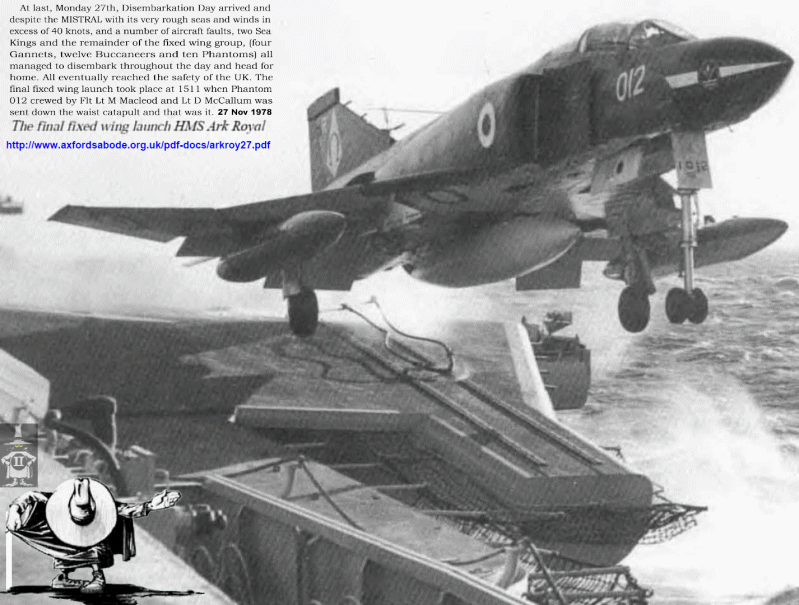
SLOW MOTION Catapults A4Gs 886 & 889
Side View of the ex-Foch NAe São Paulo Strop Catcher at woik:
http://www.naval.com.br/blog/wp-cont...9/04/af-11.jpg
Bridle Capture Explaino: User:Ralph Lewis - Wikipedia, the free encyclopedia
Phinal UK Fantom Catapult Mit Strop Catching:
PHROM: http://www.axfordsabode.org.uk/pdf-docs/arkroy27.pdf (1.5Mb)

SLOW MOTION Catapults A4Gs 886 & 889
Last edited by SpazSinbad; 9th Dec 2013 at 16:37. Reason: Add Xtra Content
Join Date: Apr 2009
Location: Sydney
Age: 45
Posts: 243
Likes: 0
Received 0 Likes
on
0 Posts
In keeping with the general theme of this thread, F4 ops on HMS Ark Royal and the F14A on USN carriers would be two of the most spectacular sights in aviation. Sadly not much these days can match them.
Join Date: Aug 2007
Location: Southampton
Age: 54
Posts: 144
Likes: 0
Received 0 Likes
on
0 Posts
According to some of the dusty tomes on my shelf, the strops used on Ark in the 70s were of two types, a standard one used by the Buccaneers and the Gannets which cost £5 each (in early 70s prices, when the average wage was between £30 and £50 per week pre the oil crisis) whilst te F-4s used strengthened ones that cost around £15 each. The need for the catcher is easy to understand.
Join Date: Jul 2008
Location: Australia OZ
Age: 75
Posts: 2,575
Likes: 0
Received 51 Likes
on
45 Posts
HMS Victorious 1966 FlyCo and Bridge seen after the boring RAS bits at beginning along with air ops as described....
HMS VICTORIOUS - British Pathé
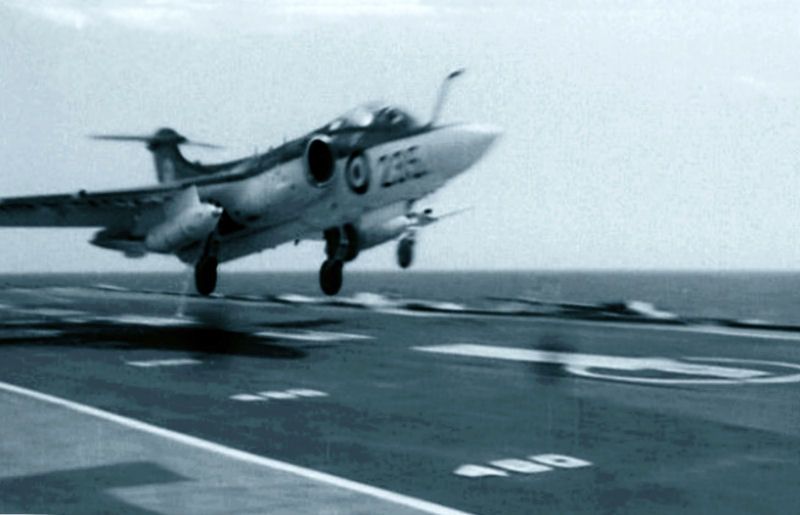
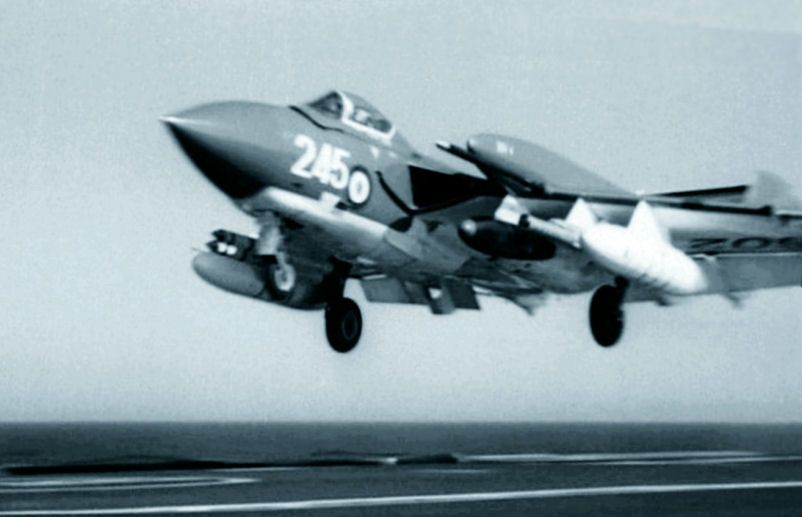
HMS VICTORIOUS - British Pathé


“Including a lot of air view of aircraft carrier ship HMS Victorious being refuelled by the tanker RFA 'Orangeleaf' while at sea. Aerial from helicopter as it lands on deck of Victorious. Royal Navy Buccaneers planes coming in to land. Lowering planes into hold. Scenes in control tower as planes land. Arrester wires in operation. Batman warning and bringing in planes. Catapult and arrester. Activity on bridge and flight deck. (Orig. Neg.) Old record suggests material dates from around 01/05/1966."
Thanks for all the clarification on the strops. One more question (and I promise to give it a rest then). How is the strop released from the aircraft. The slow motion movie of the A4 clearly shows the strop going slack, but the engineer in me is still trying to figure out the 'nuts and bolts' of how it works.
Join Date: Jul 2008
Location: Australia OZ
Age: 75
Posts: 2,575
Likes: 0
Received 51 Likes
on
45 Posts
Stroppy Explanation
From the link above (admittedly a lot of text - however searching the page with the 'Edit' look for word 'capture' will find this text block [the figures are not there so I'll supply an A-4 diagram]:
User:Ralph Lewis - Wikipedia, the free encyclopedia
"Bridle Capture.
For a long time the bridles were regarded as expendable and went overboard after falling away from the machine as it flew away. But more and more intensive flying, the fact that every aircraft type required it’s own special bridle and so placed a demand on storage space on long cruises, as well as the fact that they were becoming more elaborate and expensive, led to a search for a means of saving them. Avoiding damage to the departing aircraft was an obvious requirement, which could occur because of the tendency of the bridle to whip or flail about as it was captured.
It was to be a long time before satisfactory means of doing this were evolved. The author recalls some early attempts, in the late 1940s, by Commander (E) E.C.Beard at the Carrier Equipment Division at R.A.E. Farnborough, to start a systematic study of the mechanics of bridle arrest. An Avenger aircraft was used, but the work was abruptly stopped, it was said because a naval officer was trespassing on R.A.E’s turf.
Van Doorn Unit.
Be that as it may, it was more than ten years after that before the definitive - Van Doorn - unit appeared in service. The system is shown in
Installed on the post WW2 Carriers, HMS’ Eagle and Ark Royal and on most American ships as well, it was in essence a water cooled disc brake connected to a bridle arrest shuttle through a flexible steel driving strap.
The shuttle ran in its own grooves on either side of the main catapult track and was pulled along by lanyards hooked on to the aircraft towing bridle. It then had to be stabilised by three other free running followers, two ahead and one alongside it, also running in it’s grooves.
The lanyards hooking these four travelling elements together were of nylon rope and one pair, located between cleats formed low down near the towing bight of the bridle ran one to each of the forward followers. Another ran directly from the port side towing eye of the bridle to the bridle arresting shuttle. The fourth, rather longer, ran from the starboard towing eye, through a cleat attached to the follower on that side and then across to the arresting shuttle.
When a launch took place, the bridle pulled the shuttle and followers along with it, through the agency of the lanyards. This drew out the steel strap from the drum in the arrest unit. At a predetermined point in the launch run, a low brake pressure began to be applied for the purpose of keeping the strap taught. About 15 feet before the end of the acceleration run the pressure increased to a level dependent upon the launch speed and bridle weight and at that point the shuttle was ready to take the bight of the bridle as the machine flew away.
The rate of bridle arrest was controlled by the brake settings and the lanyards then pulled the bridle downwards, away from the aircraft to ensure a safe departure, assisted by the downturned extension ahead of the catapult. Full brake pressure then came on and the bridle was held in about 40 feet, near the end of the typical beak like projection which are to be seen at the bows of most contemporary carriers.
The bridle was then returned to the starting position by a hydraulic motor rewinding the strap back on to the drum to be ready and in position for the next launch. A deflector plate set into the deck had to be raised to carry it past and over the stationary catapult towing hook during this recovery phase. A separate compartment to contain all this capture mechanism was below deck, alongside the main catapult room, but all the controls for launch and recovery phases were operated from the deck edge howdah.
More recently, US naval aircraft seem to have been designed to take the launch load straight into the nose wheel strut, with just a short mechanical link to the catapult towing hook which hinges away on release and does not need to be captured."
For a long time the bridles were regarded as expendable and went overboard after falling away from the machine as it flew away. But more and more intensive flying, the fact that every aircraft type required it’s own special bridle and so placed a demand on storage space on long cruises, as well as the fact that they were becoming more elaborate and expensive, led to a search for a means of saving them. Avoiding damage to the departing aircraft was an obvious requirement, which could occur because of the tendency of the bridle to whip or flail about as it was captured.
It was to be a long time before satisfactory means of doing this were evolved. The author recalls some early attempts, in the late 1940s, by Commander (E) E.C.Beard at the Carrier Equipment Division at R.A.E. Farnborough, to start a systematic study of the mechanics of bridle arrest. An Avenger aircraft was used, but the work was abruptly stopped, it was said because a naval officer was trespassing on R.A.E’s turf.
Van Doorn Unit.
Be that as it may, it was more than ten years after that before the definitive - Van Doorn - unit appeared in service. The system is shown in
Installed on the post WW2 Carriers, HMS’ Eagle and Ark Royal and on most American ships as well, it was in essence a water cooled disc brake connected to a bridle arrest shuttle through a flexible steel driving strap.
The shuttle ran in its own grooves on either side of the main catapult track and was pulled along by lanyards hooked on to the aircraft towing bridle. It then had to be stabilised by three other free running followers, two ahead and one alongside it, also running in it’s grooves.
The lanyards hooking these four travelling elements together were of nylon rope and one pair, located between cleats formed low down near the towing bight of the bridle ran one to each of the forward followers. Another ran directly from the port side towing eye of the bridle to the bridle arresting shuttle. The fourth, rather longer, ran from the starboard towing eye, through a cleat attached to the follower on that side and then across to the arresting shuttle.
When a launch took place, the bridle pulled the shuttle and followers along with it, through the agency of the lanyards. This drew out the steel strap from the drum in the arrest unit. At a predetermined point in the launch run, a low brake pressure began to be applied for the purpose of keeping the strap taught. About 15 feet before the end of the acceleration run the pressure increased to a level dependent upon the launch speed and bridle weight and at that point the shuttle was ready to take the bight of the bridle as the machine flew away.
The rate of bridle arrest was controlled by the brake settings and the lanyards then pulled the bridle downwards, away from the aircraft to ensure a safe departure, assisted by the downturned extension ahead of the catapult. Full brake pressure then came on and the bridle was held in about 40 feet, near the end of the typical beak like projection which are to be seen at the bows of most contemporary carriers.
The bridle was then returned to the starting position by a hydraulic motor rewinding the strap back on to the drum to be ready and in position for the next launch. A deflector plate set into the deck had to be raised to carry it past and over the stationary catapult towing hook during this recovery phase. A separate compartment to contain all this capture mechanism was below deck, alongside the main catapult room, but all the controls for launch and recovery phases were operated from the deck edge howdah.
More recently, US naval aircraft seem to have been designed to take the launch load straight into the nose wheel strut, with just a short mechanical link to the catapult towing hook which hinges away on release and does not need to be captured."
Last edited by SpazSinbad; 9th Dec 2013 at 19:58. Reason: format
Join Date: Jul 2008
Location: Australia OZ
Age: 75
Posts: 2,575
Likes: 0
Received 51 Likes
on
45 Posts
Strop Snatcher A-4
From this and other sources - NATOPS - is this info: ebook30.com + Plenty of catadepult drivel in this 100Mb PDF on the 'SpazSinbad' Microsoft SkyDrive page in the 'FAA A-4G Skyhawk RAN PDFs' FOLDER:
https://skydrive.live.com/?cid=cbcd6...340707E6%21119
FileName: "CHLOE&deCatapult.pdf" (100Mb) There are other assrtd. PDFs with catapult names included and whatnots.
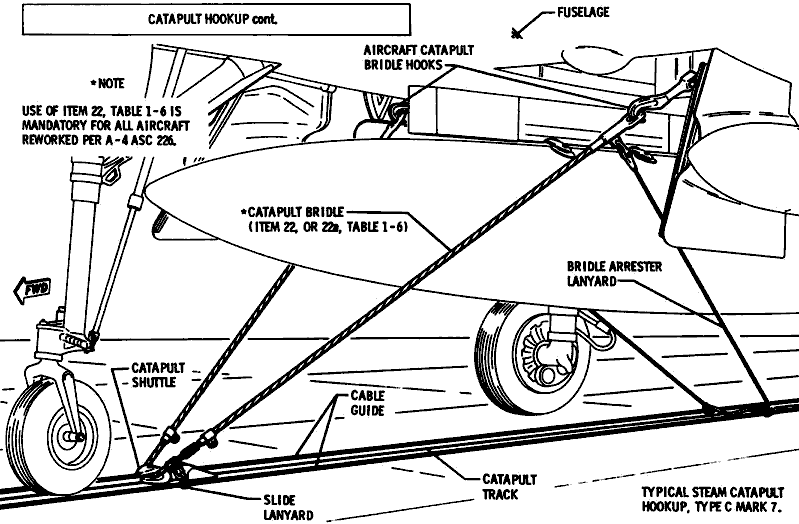
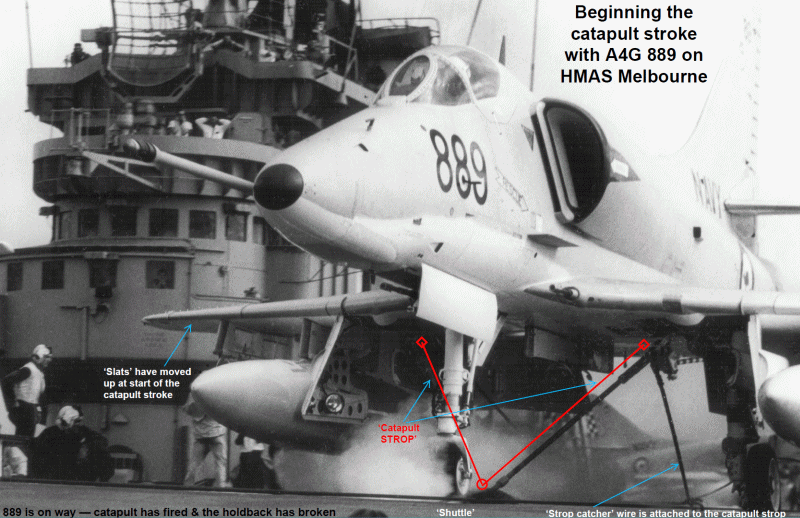
https://skydrive.live.com/?cid=cbcd6...340707E6%21119
FileName: "CHLOE&deCatapult.pdf" (100Mb) There are other assrtd. PDFs with catapult names included and whatnots.


Last edited by SpazSinbad; 9th Dec 2013 at 20:04. Reason: XtraGrfx




